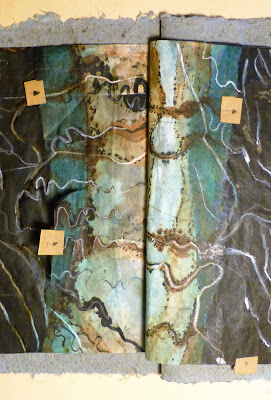"edge" is an artist proof for a larger book I hope to complete later in the year about "Kati Thanda-Lake Eyre which had historically high levels of water in it during 2019. I have been trying all sorts of work to try and come even a little close to this wonderful experience. This is my first attempt that gives just a small feeling of awe but I will keep trying for better results.
You can't really get to the actual edge of the lake, it is too shallow and boggy as the water just keeps oozing out over very flat expanses of desert. It starts to evaporate almost immediately so that its edge is not "fixed" but is very elusive and varied.

The cover is handmade paper using grass and plant fibre as the surrounding desert country near Kati Thanda - Lake Eyre is transformed into beautiful grasslands after the rains. The paper is dry but dry and fibrous with little shiny, silk-like fibres from native grasses.
Our flights over the inland sea also went into the Channel-Country and the Diamentina and Warburton rivers. The water spreads and meanders snake-like through the sand hills bringing new pastures and fish in the streams and billabongs. It is a truly wondrous sight which images can only approximate the overwhelming beautiful experience of being surrounded by it.
The book has little flaps that can be lifted to reveal surprises like small maps of descriptions of land and features. This is meant to pay tribute to the experiences of early explorers in these areas - searching for an inland sea. These can be lifted with a little lifter (DIG) provided inside the front cover.
The thin rice-paper pages are folded to make a double sided page to allow the pockets and tabs to be lifted to reveal the inside surprises - like a turkey nest.
Mixed- media used included mangrove and pomegranate inks, acrylic paint, coloured pencils, china graph pencil, maps and pastels.
The stab-bound pages roll over like the north-south sand-hills of the desert in the Simpson Desert and around Birdsville.











2 comments:
Such beautiful drawings, Jack. One of those special books you do so well, about one of the wonders of our Australian landscape.
Thank you Helen. They look a little like aboriginal paintings. When you are in a little plane you see our indigenous art in nature. They would never have seen it from the air so how did they visualise their landscape? Yes it is a wonder of our landscape -so glad I had the chance to experience it.
Post a Comment